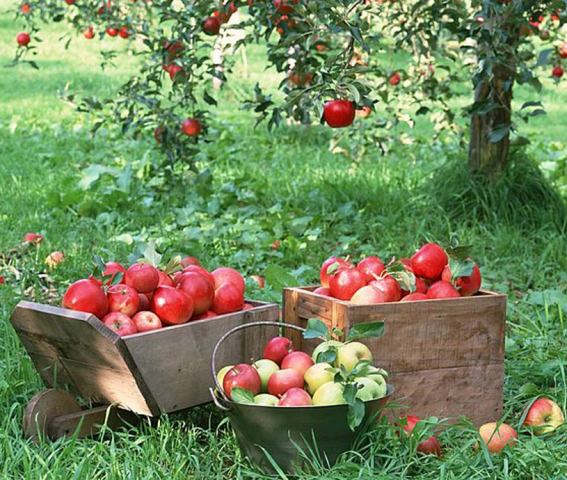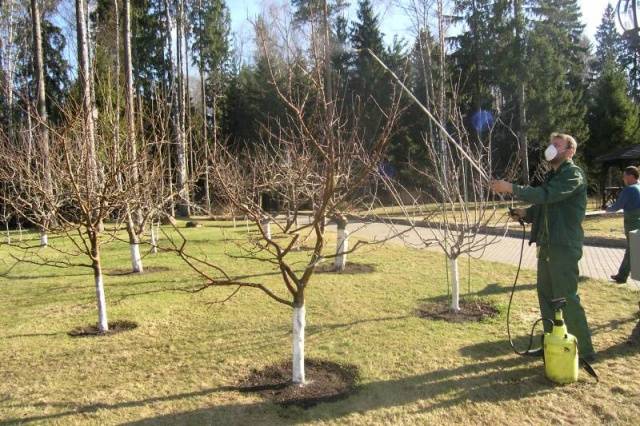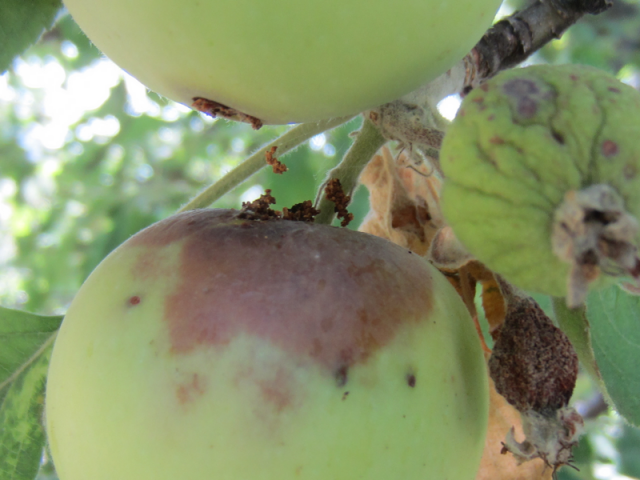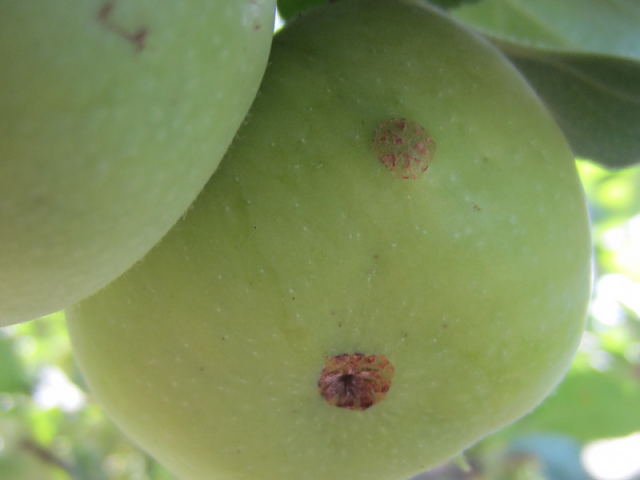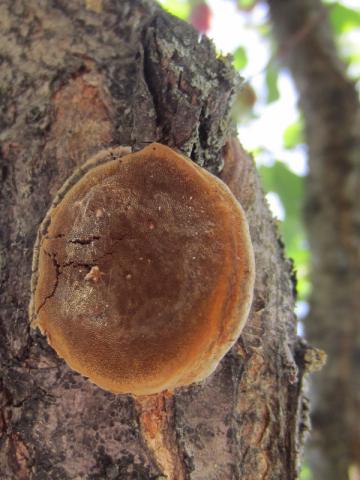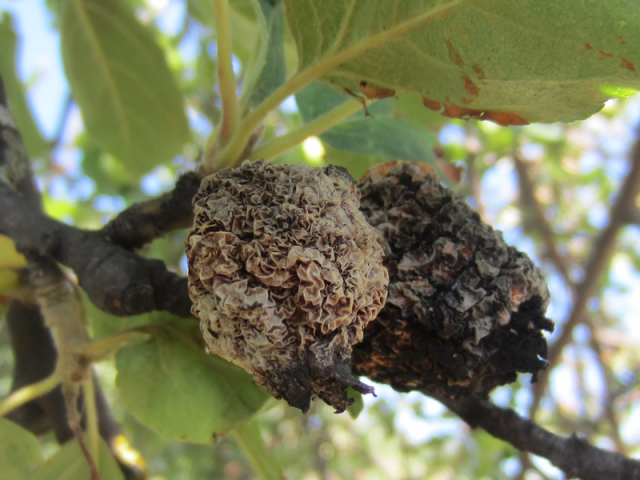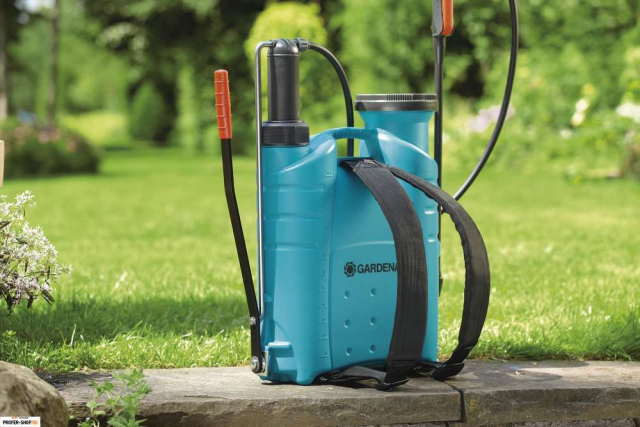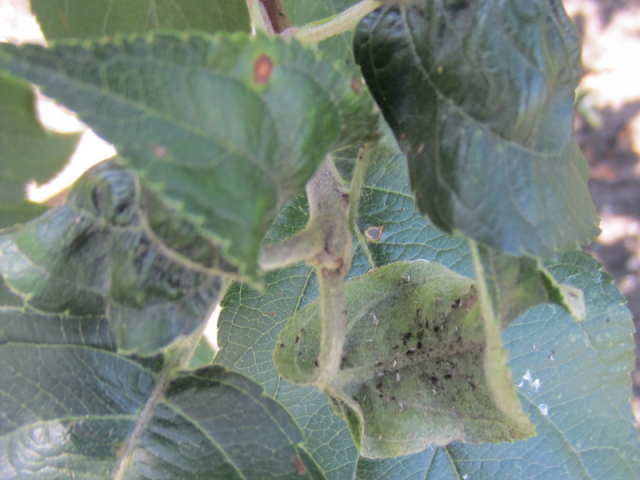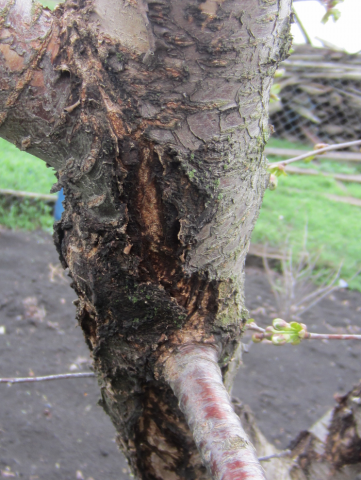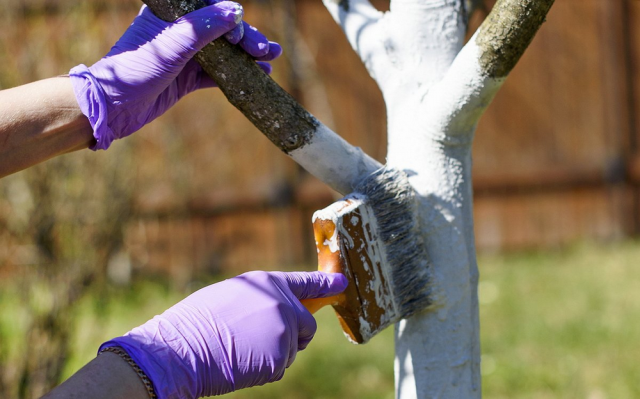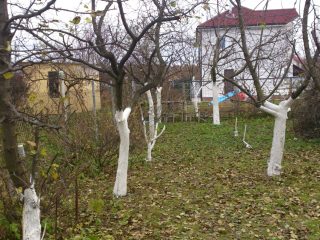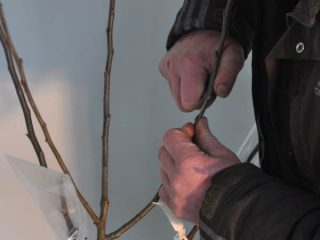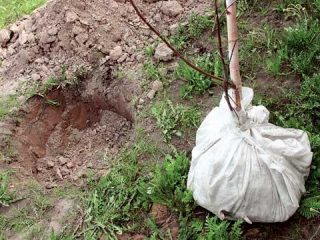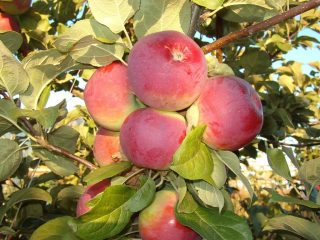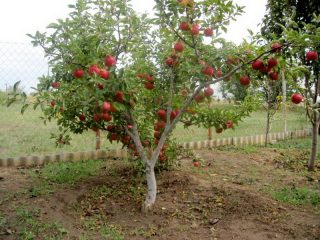Content
- 1 Why carry out processing when the apples have already been picked?
- 2 Activities that should not be neglected
- 3 Who does autumn prevention save from?
- 4 List of effective chemical defense drugs
- 5 Autumn whitewashing
- 6 Rules and recommendations
- 7 A little about other methods of protecting apple trees in autumn
By harvesting in the fall, we are essentially reaping the fruits of our labors. There is a category of summer residents for whom caring for plants ends immediately after harvesting. But we will focus on conscious gardeners. The garden requires the closest attention before winter dormancy. The queen of the orchard is the apple tree. How important is treatment apple trees in the fall? What drugs to use, and against what objects is it advisable to fight in the fall?
Why carry out processing when the apples have already been picked?
This simple question can still be confusing. Of course, it will no longer be possible to improve the quality of the harvest if the apples are damaged by the codling moth or affected by scab. But if harmful objects were marked on the apple tree, can we hope that they will not be there next year?
Attentive caring for apple trees in autumn includes a whole range of measures aimed at increasing winter hardiness, reducing the amount of infectious disease (infection) and destroying wintering swarms of the pest.
If you neglect autumn prevention, then next year, if conditions are favorable for the pest, you can expect massive damage to apple trees. And then it will be difficult to save the harvest. In autumn, phytosanitary treatment of apple trees against a range of diseases and pests protects the future harvest.
Activities that should not be neglected
Autumn measures to protect the garden can be divided into two types:
- treatment with chemicals;
- physical and mechanical means.
Both types are equally important and produce results when combined. Immediately after apple picking, pest control is activated. Spraying should be carried out at the beginning of the leaf fall of the apple tree until the night temperature drops, until the pests fall into deep anabiosis (diapause).
After leaf fall, inspect the trees for signs of disease on the bark of large branches and trunk (cytosporosis, black cancer). Local treatments may be required. To kill powdery mildew spores, brown spot and scab, spray the apple tree with fungicides.
Do not skip autumn sanitary pruning of apple trees. It is especially important for an adult fruit-bearing garden. Apple trees are pruned after leaf fall and until late autumn. Fallen leaves and carrion are a source of infection and a wintering place for pests. Plant residues along with pruned diseased branches must be burned.
Lichen and tinder fungus also need to be dealt with by cleaning and cutting from branches. They take a lot of strength from the tree and reduce its winter hardiness and immunity.After lichen, local treatment with iron sulfate (3%) is required, and after tinder fungus, treatment with copper sulfate (5%) is required.
The final procedure is whitewashing the trunk and the bases of the skeletal branches. This treatment allows you to destroy some of the hidden pests and protect the apple tree bark from cracks. In winter, the sun's rays reflected from the snow pose a great threat (especially in February). After whitewashing, this threat disappears.
By completing the activities described above, you will prepare the apple orchard for winter dormancy and reduce the amount of spring work.
It is impossible to grow healthy apples completely without chemical treatment, but if you carry out preventive spraying against pests and diseases in the fall and make full use of physical and mechanical methods, then it will be easier to obtain an environmentally friendly harvest.
Who does autumn prevention save from?
Preventive spraying of apple trees is aimed at reducing the number of pests and eliminating pathogens. Below we present a table with a list of harmful objects of the apple tree and wintering places.
Harmful object (pest/disease agent) | Overwintering stage | Where is it saved? |
codling moth | older caterpillars | in the cracks of the bark, under fallen leaves |
Aphid | eggs | on young growth, at the base of buds, on shoots |
Spider mite Red apple mite | eggs | at the base of the buds, in the cracks of the bark |
Apple moth | 1st instar caterpillars | on branches under a moisture-proof shield (spraying is not effective) |
Rose leaf roller Kidney spinner | eggs younger caterpillars | on the bark of trunks and branches near the buds, on young shoots |
Apple flower beetle | imago (adult beetles) | in the cracks of the trunk, under the leaves |
Winter moth | eggs | on the bark next to the buds |
Wrinkled marshweed | larvae | in the passages under the bark |
Scab | fruiting bodies | on fallen leaves and fruits |
Fruit rot | mycelium | in mummified fruits, in affected branches |
Cytosporosis | fruiting bodies mycelium | on affected branches inside the cortex |
Black cancer | fruiting bodies, mycelium | in bark, leaves, fruits |
Powdery mildew | mycelium | in the kidneys |
When analyzing the table presented, pay attention to the wintering stage. Treating apple trees against pests is advisable when they are in the active stage. Higher doses will be required to destroy pest eggs. Therefore, trees are treated only when the phytophage population is high.
Among apple tree diseases, there are those that require mandatory preventive treatment. These include scab and fruit rot. Processing must take into account the recommended doses and temperatures for a particular drug.
List of effective chemical defense drugs
The timing of chemical treatments for apple trees depends on the product used and the purpose of the application. If spraying is carried out on foliage, it is not allowed to exceed the recommended doses. After leaf fall, doses of drugs can be higher, which makes it possible to combat inactive stages of pests and disease spores. Let's look at how you can treat a fruit-bearing apple tree in the fall against diseases and pests.
To reduce toxic load on the trees It is recommended to use broad-spectrum drugs. For example, treating apple trees with copper sulfate protects against scab and fruit rot, and also destroys flower beetles and mites.
Preparing tank mixtures of preparations is not always possible, and repeated treatments over 1 - 1.5 months will lead to burns and death of the tree. When choosing a drug, focus on the most pronounced objects and fight against them.
Urea (urea)
Apple trees are treated with urea throughout the growing season. Just change the concentration of the working solution. In autumn, its concentration can be 5 - 7%, and after complete shedding of leaves - 10%.
Treatment of apple trees with a nitrogen-containing preparation cannot begin before leaf fall, as this will negatively affect winter hardiness. Urea can be applied when about 70% of the leaves have fallen and until late autumn. When the number of pests is high, not only trees are treated, but also the soil around the tree trunks. Young apple tree seedlings are treated with lower concentrations (no more than 5%). Preventive autumn treatment with urea makes it possible to curb the spread of many dangerous apple tree pests by destroying overwintering eggs and larvae. Spray trees preferably on a cloudy day or evening. In the sun there is a high risk of burns. The drug showed itself well in the fight against aphids. If there is a high degree of pest damage, it is advisable to cut off and burn the infested apple tree shoots.
Copper sulfate
Treatment with a 1% solution of copper sulfate is used against pest larvae and mites. Due to the high toxicity of the drug, treatment of apple tree diseases is reduced to local treatments of the affected bark on the trunk. Preventative treatments protect apple trees for scab and moniliosis (fruit rot).
inkstone
The action of the drug is similar to copper sulfate. For spraying, take a 0.1% solution, for local treatment - 3%.Harmful objects - pathogens of scab, black cancer, cytosporosis, all stages of pests. Treating apple trees with iron sulfate replenishes the deficiency of an important microelement. Can be processed in autumn trunk circles, enriching the soil with iron.
Colloidal sulfur
A 1% suspension of sulfur in water is prepared. During processing, the drug is not toxic, but under the influence of sunlight, vapors are formed that poison colonies of mites and pathogens of apple trees. The drug is highly effective in combating diseases such as powdery mildew and scab.
Bordeaux mixture
It is a less toxic analogue of vitriol. The drug consists of lime and copper sulfate dissolved in water. Some gardeners replace lime with clay. The finished dry preparation can be purchased at a specialized store. Bordeaux mixture should be in the garden medicine cabinet. With it, you will always have something to treat your apple tree against scab and other fungal diseases. In autumn, the drug can be used not only to protect apple trees, but also other fruit and berry crops.
Drug 30+
An effective contact insecticide that forms a film on the surface of an insect, larva or egg. The film prevents the penetration of air and leads to the death of the pest. This is one of the best pest repellents in the fall.
Systemic drugs
Complex tank mixtures can be made from systemic drugs that solve several problems at once. In the fall, Strobi, Skor, Topaz, and Horus will help against diseases. They can be used immediately after picking apples, without waiting for the leaves to fall, since their phytotoxicity is minimal. Aktara and Karbafos will save the apple tree from aphids and caterpillars. They can be added to the same tank with fungicides.
Separately, it is worth mentioning bacterial preparations (Lepidocide, Entobacterin, Fitosporin). Treatment with biological products should be carried out in September on warm sunny days. The higher the temperature, the better. The inclusion of biological products in the apple tree protection system does not allow the use of general exterminating chemicals.
Now you know what to spray apple trees with in the fall and how to do it as efficiently as possible. Garden treatment in the fall also includes whitewash trunks and bases of skeletal branches.
Autumn whitewashing
Whitewashing apple trees protects from burns and destroys pests; the disease of the trunk bark progresses less. The older the tree, the thicker the whitewash layer.
A simple aqueous solution of slaked lime (or chalk) with copper sulfate can be supplemented with clay, laundry soap and horse manure. Processing with such a mixture will be more reliable.
Whitewashing is carried out at the last stage after all the procedures described above. The apple tree trunk is treated with the solution to a height of at least 150 cm, including skeletal branches. The concentration of the drug is not more than 20%.
Rules and recommendations
Use only approved products with a valid expiration date for your garden. Beware of fakes, check with the seller for a quality certificate. Treatment of the garden in the fall against pests and pathogenic microorganisms is no different in technique from spring procedures. Personal protective equipment is required. All treatments are carried out on a dry, windless day.
All trees are treated in one day. Use a sprayer with good atomization. The smaller the drops, the more uniformly the drug solution will be applied. The device must be looked after, kept clean, and the atomizer and filters must be cleaned.The drugs cannot be used at subzero temperatures.
In addition to the apple tree, the described preparations protect other fruit trees, berry trees and flower and ornamental plants. For example, all perennial plants suffering from aphid attacks can be treated with urea.
A little about other methods of protecting apple trees in autumn
In protecting the apple orchard, you should not neglect old-fashioned methods. Take the time to set up trapping belts to catch caterpillars in the spring. Install protective nets against hares on the whitewashed boles. Such protection is especially necessary for young trees and apple tree seedlings.
It is better to replace digging around the tree trunks with loosening, which gives the same result, but is not dangerous for the root system of the apple tree. The tree trunks of the seedlings are mulched, increasing winter hardiness.
In the fall, treating the apple orchard is as important as disinfecting the greenhouse. Never miss these events.
